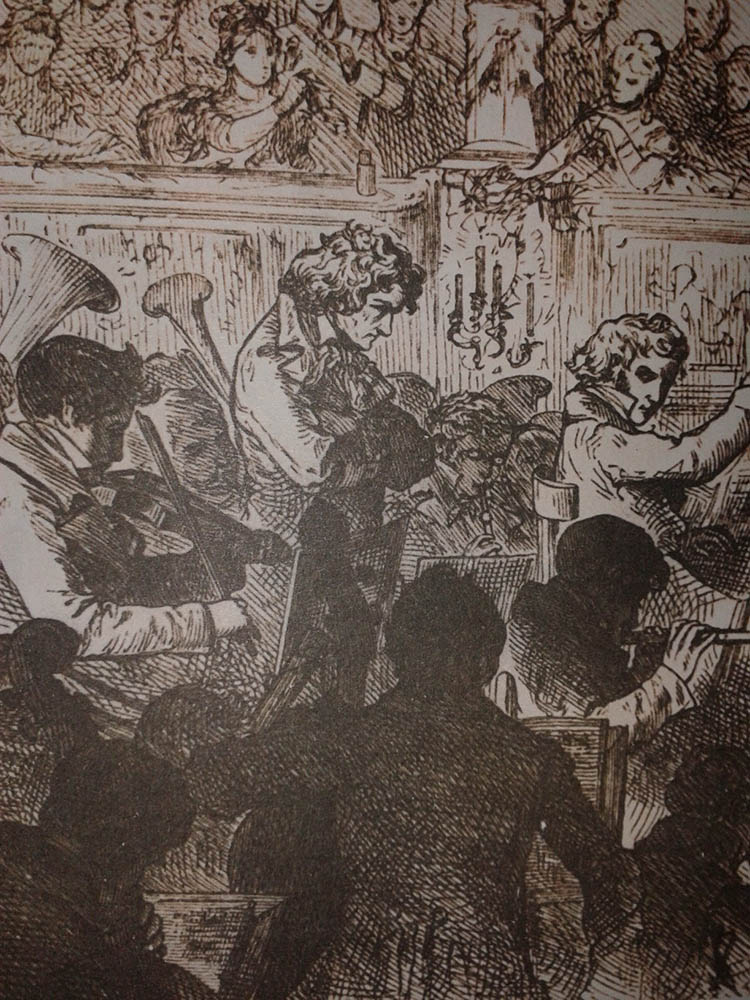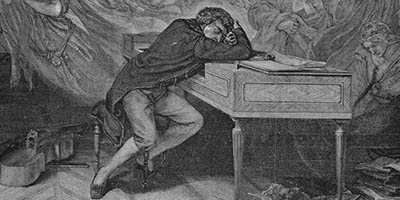
Putting it Together:
Beethoven's Symphony No. 9 in D minor, "Choral" (1824)
By Alexander Lawler
Beethoven’s Ninth Symphony stands as the culmination of Beethoven’s twenty-four-year career as a composer of symphonies. The Ninth both sums up Beethoven’s artistic career and, with the choral finale, daringly points the way forward to new conceptions of what a symphony could say and be. Listen below to Music Director Franz Welser-Möst discuss the Ninth’s first three movements and how they tie into Beethoven’s musical past, before investigating the famous choral finale.
Franz introduces the topics and themes of the first three movements of the Ninth Symphony
I. Allegro ma non troppo, un poco maestoso

As Franz describes, the first three movements of the Ninth Symphony recall past ideas and themes that Beethoven had previously explored. The first movement is a depiction of dark fate, of death. Franz connects this to the funeral march from the Eroica but also to the idea of creation (the universe). The bare intervals of the octave, fifth, and fourth that open the movement do not indicate any one particular key, and thus function as a sort of primordial mist from which the movement emerges.
II. Molto vivace (Scherzo and Trio)
The Cleveland Orchestra, with Lorin Maazel, performing the Scherzo from Beethoven’s Ninth Symphony in Mexico City, 1977.
The second movement explores dance and movement, as in the Seventh Symphony. A puckish scherzo, the movement shows the different ways the same kinds of motion can be interpreted, as Beethoven uses all of his compositional resources to shift between menacing, joyful, and mischievous moods. In the trio, Beethoven returns to the bucolic mode of the Pastoral symphony.

III. Adagio molto e cantabile
The third movement strongly recalls the second movement of the Fourth Symphony. A beautiful, long-breathed melody co-exists with a rhythmic fanfare that inspires hope. Franz connects this gesture to Freemasonry, the semi-secret organization that in Beethoven’s time was associated with liberal, revolutionary politics.
IV. Finale
The finale to the Ninth Symphony is a grand drama in which Beethoven explores and extols the idea of universal brotherhood. The movement famously is a setting of Friedrich Schiller's Ode to Joy (1785). Schiller was an influential German poet, playwright, and philosopher who was associated with the Aufklärung (German Enlightenment), and strongly believed in the power of the arts to elevate humanity by imparting knowledge and morality. His Ode to Joy, "rich with notions of liberty," was variously interpreted throughout its history as being religious, Freemasonic, revolutionary, and a "harbinger" of romanticism.1 In Beethoven's hands, the poem takes on a more explicitly Promethean tone.

Beethoven begins his Promethean drama with an unexpected and violent introduction, which Wagner described as the Schreckensfanfare ("Terror Fanfare"). Musicologist Esteban Buch describes what follows this arresting opening as a "search" by the "composer/soloist" to find a melody that can be sung by all. Recalling and rejecting each of the three earlier movements, ultimately, the "Ode to Joy" theme is discovered; it becomes the chosen melody by which the community (the chorus) can be led in song in a "learning or apprenticeship process."2 This is emphasized in Beethoven's music in a few ways: The Ode to Joy melody begins in the lowest registers of the strings, and slowly grows to encompass the entire orchestra in a musical depiction of one voice inspiring many, in that the soloists teach the chorus the song, each singing a phrase that the chorus then takes up and expands.
Following this is a Turkish march that Beethoven biographer Jan Swafford describes as "the era's definition of a bizarre move."3Although the text's military imagery supports the march setting, that the march is Turkish requires some explanation. In Western European classical music of this era, Turkish music, marked particularly by a percussion section of bass drums, cymbals, and triangles, was frequently used to represent the exotic East. In this context, though, the usage "suggests an image of global brotherhood," which Swafford connects to the Masonic song "Mankind in East and West."4 Although the “Ode to Joy” melody performed by the Turkish band is different, it is still the same fundamental song: a musical representation of this more expansive idea of human brotherhood.
Franz discusses a less-familiar aspect of the Finale.
Later in the movement, we arrive at an extended passage for chorus with a distinctly religious cast. Franz connects this section with the Benedictus from Beethoven's Missa Solemnis (1823). As he notes, the Benedictus is the portion of the Roman Catholic Mass celebrating the Eucharist, in which bread and wine transubstantiate into the divine flesh and blood of Christ. This is a moment of great mystery, matching the religious character of this portion of Schiller's text, which asks: "Do you sense the Creator, world?" Franz is joined by Beethoven scholar Lewis Lockwood in this interpretation: Lockwood describes how Beethoven enhances this aura of religious mystery through the mingling of older modal and newer tonal harmonies and the immense dynamic and pitch space the music occupies.5

The movement concludes with an ecstatic finale, in which past elements all come together, including Turkish bands and reverent choruses, in a full-throated celebration of humanity's victorious coming together. From the dark “Terror Fanfare” of the movement’s opening we have reached the blinding, joyous light of Elysium.
Franz Welser-Möst conducts The Cleveland Orchestra at Blossom Music Center, July 11, 2015
Beethoven believed in the power of music to change humanity. Like the mythological Prometheus, he gave fire to humanity through his compositions, endowed with the bright spark of creation. From his time to ours, his music continues to set alight the hearts and minds of listeners around the world. When listening to any music, remember his words to a young pianist: “Persevere, do not only practice your art but endeavor also to fathom its inner meaning; it deserves this effort. For only art and science can raise men to the level of gods.”6

- 1 Esteban Buch, Beethoven's Ninth: A Political History, translated by Richard Miller (Chicago: University of Chicago Press, 2003), 48.
- 2 Buch, Beethoven’s Ninth, 103.
- 3 Jan Swafford, Beethoven: Anguish and Triumph (Boston: Houghton Mifflin Harcourt, 2014), 851.
- 4 Ibid.
- 5 Lewis Lockwood, Beethoven’s Symphonies: An Artistic Vision (New York: W. W. Norton, 2015), 204.
- 6 As found and discussed in Lewis Lockwood, Beethoven: The Music and the Life (New York: W.W. Norton, 2005), 9.
- Alexander Lawler worked for the Orchestra’s Archives over three seasons while working on a Historical Musicology PhD at Case Western Reserve University. First writing the “From the Archives” online essays in the 2015/16 season, next designing a photo digitization and metadata project in the 2016/17 season, and finally, in the 2017/18 centennial season with the Prometheus Project.
Essay & Audio Library

Beethoven: The Prometheus Connection
In 1812, Ludwig van Beethoven received a letter from a young pianist named Emilie M. Her letter, enclosed with a home-made embroidered pocketbook, expressed her fondness for, and appreciation of, his music.
Continue Reading
Overture to The Creatures of Prometheus
1801
Perhaps the most overt example of Beethoven’s interaction with the idea of Prometheus was his only published ballet, The Creatures of Prometheus.
Continue Reading
Leonora Overture No. 3
1806
Fidelio (1805), Beethoven’s only opera, is a celebration of freedom. In the opera, Florestan has been imprisoned by the tyrant Don Pizarro.
Continue Reading
Overture to Coriolan
1807
Beethoven’s Overture to Coriolan is the only tragic piece in our Prometheus Festival. Indeed, in spite of the intense conflict that marks much of his music, Beethoven was something of an optimist.
Continue Reading
Egmont Overture
1810
Beethoven’s Egmont Overture is one of his many concert overtures depicting different kinds of heroic individuals.
Continue Reading
Symphony No. 1
1800
In the mainstream history of Beethoven, his early works are more classical in style, hewing close to Mozart and (especially) Haydn.
Continue Reading
Symphony No. 2
1802
Beethoven first realized he was becoming deaf in the summer of 1798, at age twenty-seven. After an initial episode of total deafness, Beethoven found that his hearing had become filled with an unending “maddening chorus of squealing, buzzing, and humming.”
Continue Reading
Symphony No. 3
1804
Beethoven’s Third Symphony, the Eroica, or “Heroic,” is one of the most influential pieces of music in history.
Continue Reading
Symphony No. 4
1806
Beethoven’s Fourth Symphony seems an anomaly compared to the heroic Third and the fateful Fifth.
Continue Reading
Symphony No. 5
1808
Beethoven’s Fifth Symphony is so familiar to us now that it might be difficult to imagine it as shocking or difficult.
Continue Reading
Symphony No. 6
1808
Beethoven’s Pastoral Symphony premiered on the same concert as the Fifth Symphony (December 22, 1808). The two works were quite different: Whereas the Fifth was a difficult journey from darkness to light, the Pastoral was a genial, warm-hearted journey through the countryside.
Continue Reading
Symphony No. 7
1812
In the Seventh, Beethoven suffuses each movement with a unique and persistent rhythmic pattern.
Continue Reading
Symphony No. 8
1812
The Eighth Symphony generally has been regarded as the slightest of Beethoven’s mature symphonies because of its short length, lighter tone, and frequent return to the musical styles and forms of the eighteenth century.
Continue Reading
Symphony No. 9
1824
Beethoven’s Ninth Symphony stands as the culmination of Beethoven’s twenty-four-year career as a composer of symphonies.
Continue Reading
Grosse Fuge
1825
The Grosse Fuge (Great Fugue) is Beethoven’s most complex work. It was originally to be the last movement of his String Quartet No. 13. However, it unluckily proved to be both technically challenging for the performers and bewildering to the audience, and was, instead, turned into its own stand-alone work.
Continue Reading